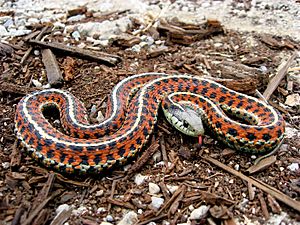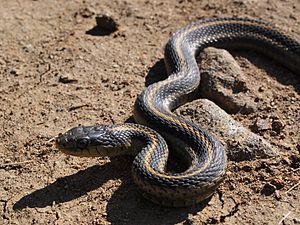Western terrestrial garter snake facts for kids
Quick facts for kids Western terrestrial garter snake |
|
|---|---|
 |
|
| T. elegans terrestris | |
| Conservation status | |
| Scientific classification | |
| Genus: |
Thamnophis
|
| Species: |
elegans
|
| Subspecies | |
|
6 sspp., see text |
|
| Synonyms | |
|
|
The western terrestrial garter snake (Thamnophis elegans) is a common snake found across western North America. It belongs to a group of snakes called colubrids, which are the largest family of snakes in the world. These snakes are known for their varied colors and patterns. There are at least six different types, or subspecies, of this garter snake.
Contents
What Does the Western Garter Snake Look Like?
Most western terrestrial garter snakes have a bright stripe down their back. This stripe can be yellow, light orange, or white. They also have two more stripes of the same color, one on each side of their body. Some of these snakes might even have red or black spots between these stripes.
These snakes are quite varied in how they look, making them sometimes tricky to identify, even for snake experts! They are medium-sized snakes, usually growing to be about 46 to 104 centimeters (18 to 41 inches) long.
Is the Western Garter Snake Venomous?
Like many garter snakes in North America, the western terrestrial garter snake has a mild venom in its saliva. If this venom gets into a small animal, it can cause muscle damage.
When humans are bitten, the effects are usually very mild. People might experience some swelling or other minor symptoms around the bite area, but it doesn't typically cause serious problems for the whole body.
How Does the Western Garter Snake Hunt?
This snake is one of the few garter snake species that can squeeze its prey, a method called constriction. However, it's not as good at it as some other snakes, like the gopher snake. The western garter snake's coils are often loose, and it takes longer for them to kill their prey this way.
Snakes from places like Colorado seem to be better at constricting their prey than those living near the Pacific Coast.
Where Do Western Garter Snakes Live?
You can find Thamnophis elegans in many places. In Canada, they live in central British Columbia, central Alberta, and southwestern Manitoba. In the western United States, they are found as far east as western Nebraska and the Oklahoma Panhandle. There's even a group of them living far away in Baja California, Mexico.
Subspecies of the Western Garter Snake
Scientists have identified six different subspecies of the western terrestrial garter snake. Some scientists still discuss if all of these are truly separate types.
- Thamnophis elegans arizonae – This is known as the Arizona garter snake.
- Thamnophis elegans elegans – This type is called the mountain garter snake.
- Thamnophis elegans hueyi – This snake is found near San Pedro Mártir.
- Thamnophis elegans terrestris – This is the coastal garter snake.
- Thamnophis elegans vagrans – This one is known as the wandering garter snake.
- Thamnophis elegans vascotanneri – This is the Upper Basin garter snake.
What is the Habitat of the Western Garter Snake?
Thamnophis elegans can live in many different environments. You might find them in grassy areas, forests, or even pine tree woods. They can live from sea level all the way up to 3,962 meters (13,000 feet) high!
These snakes mostly live on land. However, populations found in the Great Basin and Rocky Mountains areas spend some of their time in water.
Reproduction and Life Cycle
The western terrestrial garter snake does not lay eggs. Instead, the mother snake carries the eggs inside her body until they hatch. This is called being ovoviviparous. The young snakes are born live, usually in August and September. A mother snake typically gives birth to eight to 12 baby snakes at a time.
What Do Western Garter Snakes Eat?
The diet of Thamnophis elegans depends a lot on what food is available where they live. This means their diet changes based on their location, making them a great example of a polyphagous animal, which means they eat many different kinds of food. There are two main groups: coastal snakes and inland snakes.
Coastal T. elegans live near the Pacific Ocean on the West Coast of the United States. Inland populations, on the other hand, live near freshwater sources like streams, ponds, or lakes.
Coastal vs. Inland Diets
Snakes living near the coast mostly eat prey found on land. This includes things like slugs, salamanders, small mammals, and lizards.
In contrast, inland snakes have a diet that includes more aquatic (water-based) food. They enjoy eating frog and toad larvae (tadpoles), leeches, and fish. So, food from water sources is a very important part of the inland snake's diet.
Coastal snakes are less interested in fish. They don't flick their tongues as much when fish are nearby, and they are less likely to attack or eat them. This food preference is so strong that a coastal snake might even starve rather than eat food it doesn't prefer. This difference in diet seems to be something they are born with, as even newborn snakes from both groups show these preferences.
How Do They Hunt?
When hunting, western garter snakes use both smell and sight to find food, whether they are on land or in water. Both coastal and inland types use similar hunting moves. These include craning (stretching their neck), cruising (moving slowly to search), and diving. However, coastal snakes do these water-based activities less often.
These differences in what they eat and how they hunt suggest that the species has slowly changed over time, a process called microevolution. Because coastal T. elegans have different diets and hunting behaviors, it seems they have found a special way of living that means they no longer need to rely on fish as a main food source.



